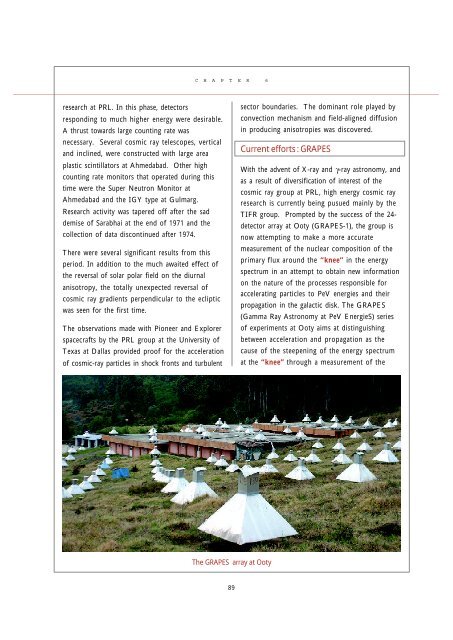2004 ASTRONOMY & ASTROPHYSICS - Indian Academy of Sciences
2004 ASTRONOMY & ASTROPHYSICS - Indian Academy of Sciences
2004 ASTRONOMY & ASTROPHYSICS - Indian Academy of Sciences
You also want an ePaper? Increase the reach of your titles
YUMPU automatically turns print PDFs into web optimized ePapers that Google loves.
CHAPTER 6<br />
research at PRL. In this phase, detectors<br />
responding to much higher energy were desirable.<br />
A thrust towards large counting rate was<br />
necessary. Several cosmic ray telescopes, vertical<br />
and inclined, were constructed with large area<br />
plastic scintillators at Ahmedabad. Other high<br />
counting rate monitors that operated during this<br />
time were the Super Neutron Monitor at<br />
Ahmedabad and the IGY type at Gulmarg.<br />
Research activity was tapered <strong>of</strong>f after the sad<br />
demise <strong>of</strong> Sarabhai at the end <strong>of</strong> 1971 and the<br />
collection <strong>of</strong> data discontinued after 1974.<br />
There were several significant results from this<br />
period. In addition to the much awaited effect <strong>of</strong><br />
the reversal <strong>of</strong> solar polar field on the diurnal<br />
anisotropy, the totally unexpected reversal <strong>of</strong><br />
cosmic ray gradients perpendicular to the ecliptic<br />
was seen for the first time.<br />
The observations made with Pioneer and Explorer<br />
spacecrafts by the PRL group at the University <strong>of</strong><br />
Texas at Dallas provided pro<strong>of</strong> for the acceleration<br />
<strong>of</strong> cosmic-ray particles in shock fronts and turbulent<br />
sector boundaries. The dominant role played by<br />
convection mechanism and field-aligned diffusion<br />
in producing anisotropies was discovered.<br />
Current efforts : GRAPES<br />
With the advent <strong>of</strong> X-ray and γ-ray astronomy, and<br />
as a result <strong>of</strong> diversification <strong>of</strong> interest <strong>of</strong> the<br />
cosmic ray group at PRL, high energy cosmic ray<br />
research is currently being pusued mainly by the<br />
TIFR group. Prompted by the success <strong>of</strong> the 24-<br />
detector array at Ooty (GRAPES-1), the group is<br />
now attempting to make a more accurate<br />
measurement <strong>of</strong> the nuclear composition <strong>of</strong> the<br />
primary flux around the “knee” in the energy<br />
spectrum in an attempt to obtain new information<br />
on the nature <strong>of</strong> the processes responsible for<br />
accelerating particles to PeV energies and their<br />
propagation in the galactic disk. The GRAPES<br />
(Gamma Ray Astronomy at PeV EnergieS) series<br />
<strong>of</strong> experiments at Ooty aims at distinguishing<br />
between acceleration and propagation as the<br />
cause <strong>of</strong> the steepening <strong>of</strong> the energy spectrum<br />
at the “knee” through a measurement <strong>of</strong> the<br />
The GRAPES array at Ooty<br />
89
















